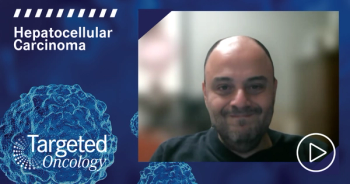
Case 3: Selecting Therapy for Metastatic HCC
Taking recent clinical trial data into account, panelists consider the best treatment option for a patient with metastatic hepatocellular carcinoma.
Episodes in this series

Transcript:
Aparna Kalyan, MD: We know that this is a patient with metastatic cancer. How would you approach this patient in terms of picking treatment options, or coming up with a treatment plan for her?
Ben George, MD:For most of us, the frontline treatment for metastatic disease—unless there are counterindications—is the combination of bevacizumab and atezolizumab. This seems like a Child-Pugh A patient. What was not mentioned in the history, and so we need some additional information, is when was the most recent endoscopy? If there wasn’t a recent endoscopy, maybe we get an endoscopy to make sure there aren’t any viruses. I’d typically go with bevacizumab and atezolizumab in the absence of counterindications for this patient. We could talk more about the special circumstances where you would go away from bevacizumab-atezolizumab and think about other options. But I’ll stop here. I’d like to hear your thoughts, Dr Kalyan.
Aparna Kalyan, MD: I echo your thoughts, Dr George. The data that have come out from IMbrave150 point to using the combination of atezolizumab plus bevacizumab as frontline therapy. About 15% or so of patients, for a multitude of reasons, are not able to get Avastin [bevacizumab]. Whether it’s variceal bleeding or hypertension, there are multiple reasons why they’re not able to get it. Those patients benefit from a TKI [tyrosine kinase inhibitor] approach. In that setting, I tend to use lenvatinib based on the REFLECT trial, mainly because it tends to be better tolerated than sorafenib, based on our experience with it. Most patients are treated with an I/O [immuno-oncology] combination.
It’s interesting to think about what may change, given the recent results of tremelimumab plus durvalumab. That’s an interesting area, and we don’t know how that’s going to change. We must wait and see. Dr Kim, what are your thoughts are on this? Sometimes we have this discussion at our tumor board: if patients have metastatic disease, is there a utility in targeting the largest region, or larger lesion, with some form of a lytic therapy and then continuing systemic therapy? It’s entirely in a palliative regimen, not with the intent of changing the course of the treatment but more the phenomena of generating neoantigens and getting a better response from that standpoint. What your thoughts are on that, Dr Kim?
Edward Kim, MD:We’re intrigued. We also have trials running here. Looking at the potential immunomodulatory effect of locoregional therapy, particularly with radiation, to incite T-cell activation and potentiate the effects of CheckPoint inhibitors. We’re investigating that. There are also trials ongoing across the country that are investigating that. When it comes to this patient, I know the patient is Child-Pugh A, but the total bilirubin is borderline at 2.2 mg/dL. I’d be more in favor of this situation because the data have been strong with Child-Pugh A patients who are in the advanced stage in terms of systemic therapy. My only concern, which was cited before, is that these patients are on atezolizumab-bevacizumab and need the endoscopy, and that could sometimes delay treatment and have a risk of variceal rupture.
The patient also had hypertension, which is controlled on ACE inhibitors, but maybe that gives pause. I’m not an oncologist, but lenvatinib caused higher rates of hypertension in that study. You also threw out the recent results of HIMALAYA. Maybe the PD-L1 and CTLA4 combined don’t have any effect on hypertension and all that stuff theoretically, but that could also be another tool for oncologists to use. I’m OK with that because as long as patients derive the benefits from all that, we can always add locoregional therapy later if needed. But in this patient population with metastatic disease and good underlying liver function, I say give them a shot at a systemic therapy. The objective response ranges anywhere from 30% to 40%. But if they’re in that group, they benefit. We’ve seen some dramatic responses in checkpoint inhibitors. Give them a shot. If they’re not in that group, then certainly we can supplement with local neoadjuvant therapy.
Aparna Kalyan, MD: Dr George, until now, assuming we didn’t have a clinical trial, this patient probably would have gone on atezolizumab plus bevacizumab, barring varices or bleeding issues. Do the data from HIMALAYA make you think about considering that? What do you think the future is going to look like with those data coming out?
Ben George, MD:It’s an exciting time for medical oncologists, isn’t it? I want to go back to the previous issue of local approaches for patients with metastatic disease. One situation that we look at in our tumor board is if the tumor is anatomically large enough to cause mass effect on the bile duct, or vascular structures, then you ask the question while administering systemic therapy. Is there any value in doing some local therapy to be able to obviate that mass effect for faster response? Coming back to your question about HIMALAYA, that’s fascinating because first and foremost, there’s the idea that CTLA4 antagonists, along with checkpoint blockade, clearly seem to be giving a strong signal with excellent outcome. We see that in the second-line setting with the CheckMate data. We see that in the frontline setting. We’ve seen that with the higher dose of triamine. We also see that with the higher dose of ipilimumab in the second-line setting. It seems as if higher-dose CTLA4 inhibition and priming may give a longer tail to the curve, either on the frontline or second-line setting.
The question then becomes, how do we sequence our therapies? What’s the trade-off in terms of adverse effects with the combinatorial therapies, the response being somewhat equal in a sense? If you look at the second-line CheckMate data—ipilimumab 3, nivolumab 1, response of about 32%—we’re looking right at about 30% with our bevacizumab-tisotumab data. We know the long term data are coming out, and maybe we’ll talk about it down the road. Those data are preliminarily looking good. The COSMIC-312 data preliminarily don’t look too bad. We’re still waiting for the final readout. There are all kinds of combinations, whether it’s a dual immune modulation vs a TKI plus immunotherapy or anti-VEGF plus immunotherapy, that merits a long discussion.
Transcript edited for clarity.













































